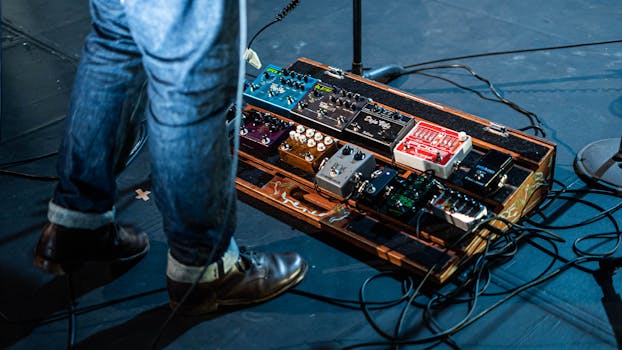The Ultimate Guide to Setup
Guitarists everywhere know the importance of a well-organized pedalboard. It’s the backbone of your tone and can make or break your live performance or recording session. This guide will walk you through everything you need to know about setting up a pedalboard, form choosing the right pedals to organizing them efficiently.
Introduction
Whether your a seasoned musician or just starting, understanding how to set up a pedalboard is crucial. A pedalboard not only keeps your effects pedals organized but also helps streamline your signal chain, ensuring that your tone remains consistent and pristine. In this article, we’ll cover the essential steps to create a functional and effective pedalboard setup.
Why a Pedalboard is Essential
A pedalboard serves as a platform to mount your guitar effects pedals. It helps in:
– Keeping your pedals organized and accessible
– Protecting your pedals from damage
– Simplifying setup and teardown during gigs
– Enhancing the signal flow and reducing cable clutter
A well-planned pedalboard can significantly improve your playing experiance and ensure that your tone remains unaffected by external factors.
Choosing the Right Pedals
Understanding Different Types of Pedals
Before you start building your pedalboard, it’s essential to understand the various types of pedals available. These include:
– **Overdrive/Distortion Pedals:** These pedals are used to add grit and saturation to your guitar sound.
– **Modulation Pedals:** This category includes chorus, flanger, phaser, and tremolo pedals, which add movement and depth to your sound.
– **Delay/Reverb Pedals:** These pedals create echo and space, adding ambiance to your tone.
– **Compressor Pedals:** Compressors even out your signal, enhancing sustain and reducing volume spikes.
– **EQ Pedals:** These pedals allow you to shape the tonal characteristics of your sound.
– **Tuner Pedals:** Essential for keeping your guitar in tune during performances.
Selecting Pedals Based on Your Playing Style
Your choice of pedals will depend largely on your playing style and the genres you play. For instance:
– **Blues and Rock:** Overdrive, distortion, and wah pedals are are staples for these genres.
– **Ambient and Shoegaze:** Delay, reverb, and modulation pedals are crucial for creating lush soundscapes.
– **Funk:** Envelope filters and compressors are often used to acheive the signature funk sound.
– **Metal:** High-gain distortion, noise gate, and EQ pedals are essential for metal players.
Budget Considerations
Pedals can vary significantly in price, from affordable options to high-end boutique models. its important to set a budget and prioritize pedals that will have the most significant impact on your sound. SOmetimes, investing in a few high-quality pedals can be more beneficial then having many lower-quality ones.
Planning Your Pedalboard Layout
Signal Chain Order
The order in which you place your pedals can have a significant effect on your tone. A typical signal chain order might look like this:
1. **Tuner**
2. **Compressor**
3. **Overdrive/Distortion**
4. **Modulation (Chorus, Flanger, Phaser)**
5. **Delay**
6. **Reverb**
However, there are no hard and fast rules, and experimentation is encouraged to find what works best for you.
Power Supply
A reliable power supply is crucial for a noise-free performance. Consider the following when choosing a power supply:
– **Isolated Outputs:** These help to prevent noise and hum by isolating each pedal’s power.
– **Current Requirements:** Ensure the power supply can handle the combined current draw of all your pedals.
– **Voltage Requirements:** Some pedals require higher voltages; make sure your power supply can accommodate these needs.
Cable Management
Proper cable management is essential for both functionality and aesthetics. Use high-quality patch cables and consider using zip ties or cable ties to keep everything neat and tidy. This will also help in reducing noise and preventing accidental disconnections during performances.
Building Your Pedalboard
Mounting the Pedals
Once you’ve planned your layout and sorted your power supply, it’s time to mount your pedals. Here’s how to do it effectively:
– **Velcro Strips:** These are commonly used to secure pedals to the board. Apply the hook side to the board and the loop side to the pedals.
– **Pedalboard Tape:** A more durable option that provides a stronger hold.
– **Pedal Clamps:** These are used for mounting pedals without adhesive, allowing for easy repositioning.
Connecting the Pedals
With your pedals mounted, start connecting them using patch cables. Follow your planned signal chain order and make sure the cables are securely connected. Test each connection as you go to ensure everything is working correctly.
Testing Your Setup
Once everything is connected, plug your guitar into the pedalboard and run it through your amplifier. Test each pedal individually and in combination to ensure they are functioning as expected. Listen for any unwanted noise or hum and troubleshoot as needed.
Maintaining Your Pedalboard
Regular Cleaning
Dust and dirt can accumulate on your pedalboard over time, potentially affecting performance. REgularly clean your pedals and the board itself to keep everything in top condition.
Checking Connections
Periodically check all connections, including power supply and patch cables, to ensure they are secure and functioning properly. Loose connections can lead to signal loss or unwanted noise.
Updating Your Setup
As your playing style evolves, so might your pedalboard needs. dont be afraid to experiment with new pedals or reconfigure your setup to better suit your current requirements. Keeping your pedalboard up-to-date ensures that it continues to serve you well.
Conclusion
Setting up a pedalboard may seem daunting at first, but wtih careful planning and attention to detail, you can create a setup that enhances your playing experience and delivers consistent, high-quality sound. By choosing the right pedals, organizing them efficiently, and maintaining your board, you’ll be well on your way to achieving the perfect tone for any situation.
